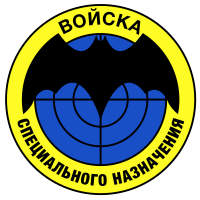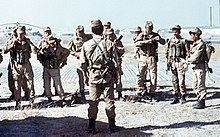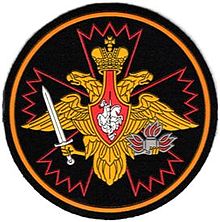GRU Spetsnaz
|
GRU Spezialnoje Nasnatschenje (GRU SpezNas) |
|
|---|---|
 Unofficial coat of arms of the Spetsnaz Army , not a GRU Spetsnaz |
|
| Lineup | November 1950 |
| Country |
|
| Armed forces |
|
| Branch of service | Special forces |
| Type | Reconnaissance unit |
| Insinuation |
|
| Butcher |
Soviet-Afghan War (1979–1989) First Chechen War (1994 to 1996) Second Chechen War (1999 to 2009) Caucasus War 2008 Crimean Crisis |
The Spetsnaz GRU ( Russian СпН, Спецназ, подразделение спец иального наз начения Российской Федерации , German transcription Podrasdelenije spec ialnowo nas natschenija Rossijskoj Federazii , German unit of the Russian Federation for special use or special task force of the Russian Federation ) is a special unit of the Russian military intelligence service GRU with a focus on reconnaissance and asymmetrical warfareand counterterrorism .
assignment
The spetsnaz of the Soviet army were established in November 1950. Its members were mainly recruited from the ranks of the military intelligence service GRU . Their original job was to scout out enemy command centers; Later, a further primary task was added to investigate mobile launching ramps for tactical nuclear weapons and, if necessary, to eliminate them. In the event of a war, the task behind enemy lines to weaken NATO forces would have been the task of this special unit. Further mission profiles developed over time.
equipment
As part of the Russian armed forces , the Spetsnaz troops also have their weapons at their disposal. In the context of training and for operations behind enemy lines, however, foreign weapons are likely to be stored, as is the case with most special forces, so that Spetsnaz members can also use captured weapons.
Since the Spetsna take over the tasks of the military and the police, heavy weapons and vehicles, such as. B. used the armored personnel carrier BTR-80 . In addition, Spetsnaz soldiers have special stimulants in tablet form with the names " Sydnocarb " or "Mesocarb", which, when taken in dangerous situations , significantly increase physical performance for a short time.
Are used assault rifles , including AK-47 , AK-74 , AK-103 , AK-101 , AK-12 , AN-94 , AKS-74U , AS Wal or OZ-14 , then guns as Yarygin PJA and GSH 18 as well as submachine guns of the types PP-19 Bison and PP-2000 . Also, machine guns of types SG-43 GORYUNOV , MG PK or PKP Pecheneg be in addition to shotguns of the type KS-23 used on long distances also the sniper rifles SWD , SWU , WSS , KSWK and WKS .
The troops can also use recoilless anti-tank handguns of the types RPG-7 , RPG-29 , RPG-30 , RPG-32 or RPO as well as machine grenade launchers of the types AGS-30 and GM-94 .
As a means of transport serving wheel armored BTR-80 , trucks ( Ural-4320 , Ural-375D ) as well as transport helicopters such as Mi-8 as well as battle zone helicopter type Mi-24 .
Guard dogs such as the Caucasian Owtscharka are used for security in action .
history

In 1966 the 3rd Guard Special Reconnaissance Brigade was set up, which until 1991 was based in Fürstenberg / Havel with the Soviet troops in Germany . In 1970 a special school for specialty officers was established. At this time soldiers were increasingly being recruited from the southern Soviet republics, as the Tajiks and Azerbaijanis also spoke the language of possible enemies, such as Farsi and Turkish . On May 2, 1979, a Spetsnaz unit was set up, which consisted almost exclusively of Uzbeks , Turkmen and Tajiks. In Operation Storm-333 , this force, together with special forces of the KGB, successfully stormed the palace of Afghan President Hafizullah Amin's in Kabul .
In 1984 the high command decided to expand the Spetsnaz operations in Afghanistan (see Soviet intervention in Afghanistan ). They were the last to withdraw from Afghanistan, before they covered the withdrawal of the regular Soviet armed forces. The hard-working Spetsnaz soldiers were feared by the rebels because of their unconventional fighting style and brought in a considerable number of "tongues" (meaningful prisoners) and fought down supply columns or mined the paths and paths of the Mujahideen. Soldiers of the 186th Spetsnaz Battalion captured the first ready-to-use American portable anti-aircraft missile "Stinger" along with technical documentation on January 5, 1987 near the hamlet of Jilawur.
Little was known about the Spetsnaz by Western secret services until the 1980s. It was not until the large amount of information from the defected GRU officer Vladimir Resun (alias Viktor Suvorov ) that the threat that these units posed to NATO became clear . Western secret services reacted with alarm to these findings and now had to further develop their defense concepts as quickly as possible. After the collapse of the Soviet Union, opinions spread on the Internet in Russia that in the mid-1980s, Spetsnaz soldiers had mined American launch sites for ICBMs of the “Minuteman” type with nuclear mines, which the Russian historian Shirokorad dismissed as a patriotic legend after careful investigation.
During and after the collapse of the Soviet Union , armed conflicts increased in the territory of the former Soviet republics, which is why Spetsnaz were deployed in Baku (see Black January ), North Ossetia , Nagorno-Karabakh (see Nagorno-Karabakh conflict ), Ingushetia and, last but not least, in Chechnya (see Chechnya wars ). Since the military budget collapsed in Russia from 1992 , there was a lack of equipment and preparation. This meant that numerous units had to be disbanded. Many experienced members moved into the private sector.
In 2014, the former American spy Igor Sutyagin claimed, according to the Financial Times , that the units in the Crimea were clearly those of the Spetsnaz .
Other Spetsnaz Associations
In Russian, Speznaz only means special association. In addition to that of the GRU, other ministries such as the FSB maintain the special units ALFA and Wympel , the Russian militia (police), the SOBR and OMON and the Ministry of Finance have other special associations. The SKIF operates in Chechnya as the Russian Spetsnaz .
The 82nd Osnaz Brigade is used for electronic reconnaissance for operational and strategic intelligence gathering .
literature
- Сергей Николаевич Козлов (Ed.): Пятьдесят лет истории, двадцать лет войны . (Speznas GRU: Pjatdesjat let istorii, dwazat let woiny). Russkaja Panorama, Moscow 2001, ISBN 5-93165-037-7 (Sergei Nikolajewitsch Koslow: 50 years of history, 20 years of war ).
- Сергей Николаевич Козлов (Ed.): Война не окончена, история продолжается . (Spetsnaz GRU-2: Voina ne okontschena, istorija prodolschajetsja). Russkaja Panorama, Moscow 2002, ISBN 5-93165-064-4 (Sergei Nikolajewitsch Koslow: The war is not over yet, the story goes on ).
- Jürgen W. Schmidt: Sketches from the history of the Soviet and Russian Speznas 1921–1995. In: Jürgen W. Schmidt (ed.): “Espionage, terror and special forces. Case studies and documents from 140 years of secret service history “Berlin 2019 pp. 176–199 ISBN 978-3-89574-965-0
Web links
Individual evidence
- ↑ US scorns Russia's version of Crimean intervention. Financial Times , March 6, 2014
- ↑ https://www.youtube.com/watch?v=i9XCW8x_uA4 THE RUSSIAN GUARD: Elite unit in the fight against terrorism | Report premiere on August 15, 2019





